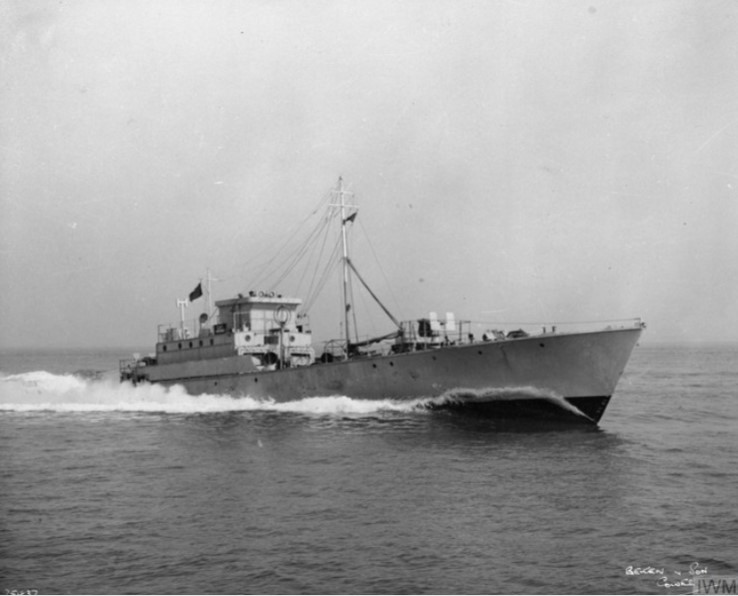
HMS Gay Viking underway as a Motor Gun Boat.
This is HMS Gay Viking. It’s actually a British answer to the E-Boat. (I think that’s a fair descriptor in that we’re talking about the Schnellboote as it existed in the British imagination, as opposed to boring old reality.) Gay Viking was built around a Paxman VRB high speed diesel engine, one of a number of high-speed diesels being pushed by British engine builders as an “answer” to the E-boat. The Navy tended to treat this as a question no-one had actually asked, and the run was limited to eight boats ordered by the Turks, of which Gay Viking was taken up by the British and used as a blockade runner on the Swedish route during the war, as it was fast enough to outrun anything the Germans could use to chase it, just so long as the engine agreed to run for the whole trip.
Operation Performance
Ever since the single successful run of their little fleet through the German blockade back in 1941, British agents George Binney and William Waring had been having a discouraging time. Early in 1942, they had chartered 10 more Norwegian vessels caught at Sweden’s Goteborg harbor by the Nazi occupation of Norway. After a legal fight in which Germany contested the proprietary rights of Norway’s government- in-exile in London, Sweden’s Supreme Court upheld the charter and released the ships to the British.
in 1943, as the War turned against the Germans, the Swedish attitude underwent considerable change. Back in England, Binney had persuaded the Ministry of War Trans- port and the Ministry of Supply that smaller, faster, more maneuverable vessels, equipped with high-powered diesel engines and designed to carry up to 45 tons, had a reason- able chance of evading German patrols off Sweden.
Binney’s idea was that the vessels should operate only in winter, when stormy weather would increase their chances of evasion-and that their sailings should coincide with periods of little or no moon. Taking into account this severely limited schedule-and also the likelihood that some crossings would be interrupted by enemy action or crippling storms-Binney computed that the vessels could deliver up to 500 tons of supplies in a winter season.
Operation Bridford
By autumn 1943, a flotilla of “pocket freighters,” as they came to be known, were ready to leave England. There were five of the little craft – the Master Standfast, the Hopewell, the Nonsuch, the Gay Corsair and the Gay Viking – each 117 feet long, built similar to a torpedo boat, manned by a hand-picked British crew of 20 volunteers, flying the Red Ensign of the Merchant Service-and adorned in the captain’s cabin by a portrait of Sir Francis Drake.
Waiting in Sweden for the arrival of the pocket freighters was William Waring. He had established an office in Lysekil -where the Swedes had given their permission, previously refused, for the freighters to operate. Conferring regularly with helpful Swedish officials. Waring used Swedish stevedores to assemble cargoes for loading.
Early on an October morning, the Gay Viking, first of the tadpole fleet to make the run, dashed through the blockade and safely entered Lysekil’s harbor-where she was welcomed by nearly 5,000 Swedish townspeople. Swedish police were detailed to watch over the British seamen (and prevent them from wandering into the port’s restricted areas). The sailors were comfortably lodged in the town’s best hotel – until, two days after her arrival, the Gay Viking was escorted by Swedish warships to the outer limit of neutral waters. From there she darted through the blockade and safely raced 600 miles to her home port of Immingham.
The pocket freighters shuttled between Sweden and Britain in fair weather and foul, mostly without mishap. Only one ship was lost: On the first sailing of the little fleet after Gay Viking’s initial run, the Master Standfast was attacked by a German patrol ship and captured after her captain was killed. The four other craft continued operating for four months, delivering 347 tons of such prized cargo as ball and roller bearings, machine tools and spare parts to England.
Name: MV Gay Viking
Builder: Camper & Nicholson
Fate: Sunk in a collision on 5 February 1945. May have been re-floated and used as civilian vessel until 1973.
General characteristics
Class and type: MGB 502 Motor Gun Boat
Displacement: 95 long tons (97 t)
Length: 117 ft (36 m)
Beam: 20 ft 3 in (6.17 m)
Draught: 4 ft 1 in (1.24 m)
Propulsion:
3 × Paxman VRB engines
3000 bhp
Speed:
28 knots (52 km/h) (max)
25 knots (46 km/h) (cruising)
Range: 2,000 nautical miles (3,700 km) at 11 kn (20 km/h)
Complement: 21
Armament:
as intended:
1 × 6 pounder Hotchkiss
1 × 2 pounder autocannon
4 × 20mm Oerlikon cannons (2 twin)
2 × depth charges
after modification:
4 × 20mm Oerlikon cannons (2 twin)
8 × .303in Vickers MGs (1 quadruple, 2 twin)